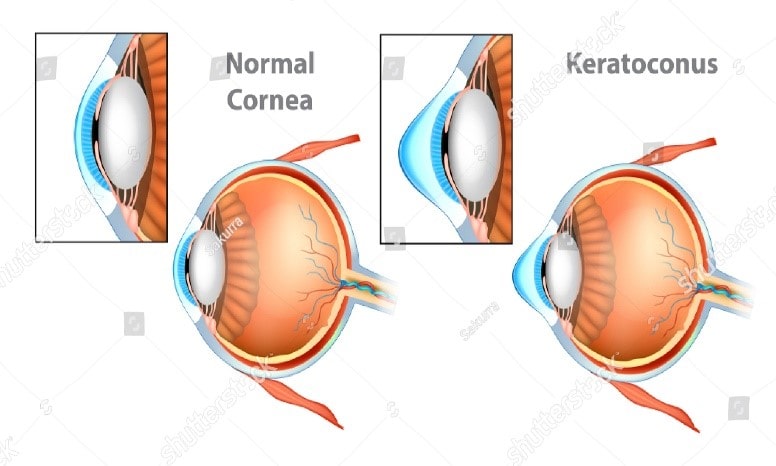 Over two decades ago, I (Dr. Brian Boxer-Wachler) developed a revolutionary way to treat keratoconus: Intacs®. Intacs are tiny, transparent semi-circle inserts placed on the outer layer of the cornea to reshape the emerging bulge that forms with keratoconus. Intacs are a less invasive solution compared to other treatments that involve removing tissue from the cornea.
Over two decades ago, I (Dr. Brian Boxer-Wachler) developed a revolutionary way to treat keratoconus: Intacs®. Intacs are tiny, transparent semi-circle inserts placed on the outer layer of the cornea to reshape the emerging bulge that forms with keratoconus. Intacs are a less invasive solution compared to other treatments that involve removing tissue from the cornea.
After studying my technique in a published medical journal article and utilizing it in clinical trials, the FDA approved this procedure as an effective treatment for keratoconus. I am proud to have been a leader in this field and to share this vision-changing procedure with all my patients.
Benefits of Intacs®
Intacs help flatten the keratoconus patient’s corneal bulge without affecting the structural integrity of the cornea. The procedure is much less invasive than comparable treatments (especially corneal transplant) because it does not involve removing or replanting tissue. This means there is no need for big incisions and no sutures, so there is less discomfort and the recovery period is easier.
Intacs are highly effective at improving quality of vision because they can provide:
- Crisper vision
- Better night vision
- Less visual distortion
- Less glare and fewer streaks of light
- Lower incidence of double vision
Most patients who use Intacs can avoid the eventual need to have a corneal transplant. However, if corneal transplant becomes appropriate, patients can have their Intacs safely and easily removed.
Intacs® Procedure Details
I start by applying numbing eyedrops. Next, I use a curved glide to gently separate the corneal tissue layers. The Intacs insert is then placed at the periphery of the cornea. Instead of stitches, I use a dissolvable tissue glue to secure the Intacs, which helps to flatten the conic shape. The entirety of this outpatient procedure is typically completed in about seven minutes, typically with no pain to the patient.
Get 3 Latest Best-Selling Keratoconus Books For Free!
(Plus a Complimentary Consultation – Value $307.00)
These books normally range from $15.99 to $22.95 each plus shipping



Combining Procedures for Maximum Effect
 For most patients, I combine Intacs with my proprietary Holcomb C3-R cross-linking system to make the most of both treatments. Corneal cross-linking is a procedure that virtually stops the progression of keratoconus with a non-invasive treatment of vitamin B and UV light. The Intacs improvement is further locked in with my unique Holcomb C3-R treatment. Nearly every patient who has these treatments combined sees positive, long-lasting visual results. We see best results when these two procedure are combined the same day vs on different days.
For most patients, I combine Intacs with my proprietary Holcomb C3-R cross-linking system to make the most of both treatments. Corneal cross-linking is a procedure that virtually stops the progression of keratoconus with a non-invasive treatment of vitamin B and UV light. The Intacs improvement is further locked in with my unique Holcomb C3-R treatment. Nearly every patient who has these treatments combined sees positive, long-lasting visual results. We see best results when these two procedure are combined the same day vs on different days.
Depending on how far keratoconus has already progressed, patients may still need to wear prescription lenses (eyeglasses or contact lenses) to correct the full extent of their refractive errors. After your procedure, I can help you determine your new vision prescription.
Watch Dr. Brian’s webinar, How to Conquer Keratoconus
FAQ’s
What are Intacs®?
In a 7-minute, pain-free procedure, Intacs® which are small crescent-shaped implants, are inserted into the cornea, which is the clear layer of tissue at the front of the eye. Intacs® are intended to be a long-term vision improvement option and are used to treat keratoconus.
How do Intacs® Work?
Keratoconus is characterized by the thinning and bulging of the cornea, which causes blurry vision, sensitivity, and other issues. Intacs® work by flattening the cornea to restore its shape.
Does keratoconus result in blindness?
Keratoconus may cause legal blindness, which can greatly impact your quality of life. Those with keratoconus can experience a gradual decline in vision, even when wearing corrective eyewear or contact lenses (if tolerated). The progression of the disease can make it difficult to participate in certain activities, making it necessary to undergo treatment. Intacs® can eliminate the need for a future cornea transplant. Other notable symptoms of keratoconus include:
- Blurred vision
- Eye redness
- Trouble seeing at night or in environments with poor lighting
- Worsening refractive errors, including nearsightedness or astigmatism
- Sensitivity to light
- Distorted vision
- Intolerance to contact lenses
Will I still need glasses after Intacs®?
Some patients still need vision correction to achieve the best vision possible. Dr. Brian can help you understand the vision correction options such as Visan EVO ICL that may be used for keratoconus in addition to Intacs® to give you crisp, clear vision.
Am I a candidate for Intacs®?
Keratoconus is a progressive disorder, which means it gets worse without treatment. Although previous treatment methods may have worked for you in the past, as the disorder progresses, certain methods become ineffective or poorly tolerated, such as soft contact lenses. Intacs® could be right for you if your keratoconus has progressed past a certain point and may help improve your vision by reversing part of the steepening from keratoconus. The best way to find out if Intacs® is right for you is to visit Dr. Brian, who will evaluate your unique circumstances and determine the best plan forward.
What are the stages of treatment for keratoconus?
Glasses or soft contacts are typically needed in the first stage of keratoconus treatment. As keratoconus progresses and the cornea bulges more, these methods may be insufficient to correct your vision. Additionally, soft contact lenses may be intolerable at this stage. Intacs® are typically introduced in mid- to late-stage keratoconus and are used to reshape the cornea without removing it.
What are the advantages of Intacs®?
Intacs® are often compared to corneal transplants, but the former has significant advantages, including:
- Fast recovery
- Removable, replaceable implants
- Delicate eye structures are not disturbed
- Slows the progression of keratoconus
- Eliminates the need for a corneal transplant
- May restore contact lens tolerance
What results can I expect from Intacs®
Intacs® can help improve the deterioration of vision due to keratoconus.
How long does surgery take?
In Dr. Brian’s “magic hands” the keratoconus procedure is painless and takes just 7 minutes. The procedure offers patients a fast and effective way to improve the effects of the condition, with only 1 day recovery!
Why You Should Choose Dr. Brian for Intacs®
No one in the world has performed Intacs for keratoconus for as long as I have – my first case was in 1999. The FDA used my research to approve these corneal inserts, which means that all other doctors who perform versions of this procedure are essentially working off my technique. This is precisely why patients travel from around the world to have their keratoconus treated here with me in Beverly Hills.
I enjoy using my knowledge and talents to help my patients to overcome and minimize the effects of keratoconus. I create a personalized plan for each of them so that they get the most out of their treatment. To receive corneal inserts from the same doctor who pioneered this treatment, please contact my office at 424-274-0958 today. You may also text us at 424-245-0171 or email info@boxerwachler.com.


